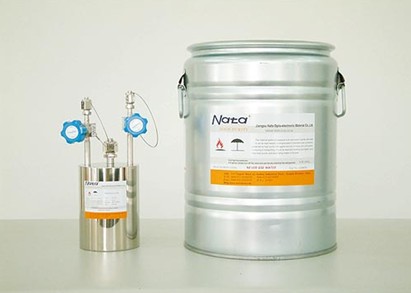At present, the MO source for LED epitaxial production mainly depends on imports. Although there are also MO sources in China, most of the domestic enterprise extension engineers are from Taiwan. Generally, the raw materials used in the past are not easily replaced, and the domestic gas sources are still in purity and productivity. There is a gap between foreign companies and foreign companies.
The only domestically produced capacity of Jiangsu Nanda Optoelectronics, which provides high-purity MO sources, is 4 tons. Although the production capacity is far behind that of foreign manufacturers, the price and transportation cost are the biggest advantages of domestic gas sources. As of September 2010, the world's top 4 MO source providers, Dow Chemical (revenue to Rohm Huss in 2009) and SAFC Hitech have established factories in the Mainland. Akzo Nobel and Sumitomo have not established a factory. plan.
Dow Chemical has significantly increased TMG production in its US plant this year, and has also established a new plant in South Korea to meet long-term capacity needs, and the new plant will operate in 2011. According to the long-term production plan developed by Dow Chemical, TMG's production capacity can be increased by 60 tons per year.
By the second quarter of 2010, the TMG production at the AkzoNobel US plant has doubled compared to the same period last year.
SAFC Hitech will invest $2 million to expand its TMG production at its UK facility.
In 2010, Jiangsu Nanda Optoelectronics will have a new TMG production line put into operation. The estimated production capacity is 10 tons. It will start trial production in October and will be put into operation at the end of the year. By then, Nanda Optoelectronics' high-purity TMG will reach 15 tons per year. The company plans to build another 1-2 TMG production lines in 2011 to further expand production capacity. The capacity is expected to be around 40 tons by then.

At present, the imported ammonia used by most of China's LED epitaxial factories is basically from the three manufacturers of Praxair, APCI and Japan's Zhaohe Electric. Among them, Japan's Showa Denko's global market share is 30%, and by the end of 2010, ammonia gas will increase from 3,400 tons to 2 times, reaching 7,200 tons. Showa Denko revealed that it has obtained technical patents for the manufacture of GaN-based compound semiconductors using ammonia with low moisture content in Japan and the United States, and is applying for patents in Korea and Taiwan. This move may accelerate the expansion of Showa's market share.
At present, only a few enterprises such as Beijing Oxygen Plant are the only ammonia production plants that are really used for large-scale practical production lines of LEDs. It is expected that at the end of this year, with the continuous installation of a large number of MOCVD equipment at home and abroad, the domestic ammonia consumption will also be large. The scale has climbed.

PVC Insulated Cable (Wire)
1. Product standard
The product is manufactured according to the standard of GB5023-1997 and JB8734-1998 or IEC, BS, DIN and ICEA upon request.
2. Application
The product is suitable for use in power installations, fixed wiring or flexible connections for electrical appliances with rated voltages up to and including 450/750V respectively.
3. Operating characteristics
Rated voltages of Underground Cable U0/U: 450/750V.300/500V and 300/300V.
Max .Permissible continuous operating temperature of the conductor:
227 IEC 07 (BV-90) 90℃
227 IEC 08 (RV-90) 90℃
For other types 70℃
The ambient temperature under installation should not below 0℃
The bending radius of cable:
D≤25mm ≥4D
D>25mm ≥6D
(D-Diameter of the cable )
4. Type and Designation:
Type:
227 IEC 01(BV), 227 IEC 02(RV), 227 IEC 05(BV), 227 IEC 06(RV), 227 IEC 07(BV-90), 227 IEC 08(RV-90), 227 IEC 10(BVV), 227 IEC 42(RVB), 227 IEC 52(RVV), 227 IEC 53(RVV), 227 IEC 74(RVVYP), 227 IEC 75(RVVY), BV, BLV, BVR, BVV, BLVV, BVVB, BLVVB, RVS
Designation:
227 IEC 01(BV): Single-core non-sheathed cable with rigid conductor for general purposes
227 IEC 02(RV: Single-core non -sheathed cable with flexible conductor for general purposes
227 IEC 05(BV): Single-core non -sheathed cable with solid conductor for internal wiring for a conductor temperature of 70℃
227 IEC 06(RV): Single-core non -sheathed cable with flexible conductor for internal wiring for a conductor temperature of 70℃
227 IEC 07(BV-90): Single-core non -sheathed cable with solid conductor for internal wiring for a conductor temperature of 90℃
227 IEC 08(RV-90): Single-core non -sheathed cable with flexible conductor for internal wiring for a conductor temperature of 90℃
227 IEC 10(BVV): Light PVC sheathed cable
227 IEC 42(RVB): Flat non-sheathed flexible cord
227 IEC 52(RVV): Light PVC sheathed flexible cord
227 IEC 53(RVV): Ordinary PVC sheathed flexible cord
227 IEC 74(RVVYP): Oil-proof PVC sheathed, screened flexible cable
227 IEC 75(RVVY): Oil-proof PVC sheathed, non-screened flexible cable
BV: Copper conductor PVC insulated wire
BLV: Aluminum conductor PVC insulated wire
BVR: Copper conductor PVC insulated and sheathed round cable
BVV: Copper conductor PVC insulated and sheathed round cable
BLVV: Aluminum conductor PVC insulated and sheathed round cable
BVVB: Copper conductor PVC insulated and sheathed flat cable
BLVVB: Aluminum conductor PVC insulated and sheathed flat cable
RVS: Copper conductor PVC insulated twisted flexible cord for connection
![]()
PVC Single Core Cable,Building Flat Wire,Flat Building Wire,Electrical Cable Wires,Underground Cable
Huayuan Gaoke Cable Co.,Ltd. , http://www.bjhygkcable.com